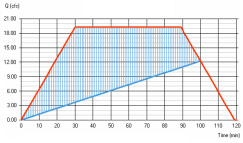This is one of those “I got to get something off my chest” blog posts. It’s about the Rational method. Before you start, imagine the theme song from Clint Eastwood’s film, “The Good, The Bad, The Ugly” playing in the background.
Being a hydrology software developer has some cool and interesting perks. One being is that you learn hydrologic methods – inside and out. When I write source code I’m forced to push an equation or a particular method to its limits. My coding experiences with the Rational method has certainly revealed its many characteristics. Here are the most notable:
The Good
Q = CiA. It’s simple. Let face it with only three terms it’s a born star among the civil engineering community. What always fascinates me is that you can plug in inches per hour; acres; and a dimensionless coefficient (C) without any conversions, and shazaam! Cubic feet per second out the other side. That’s just plain lucky and that is what’s good about this method. Simplicity.
The Bad
According to documented history, the Rational method was first used in 1851 in Ireland and by 1889 it was rampant in North America. Thank Emil Kuichling. It took some time before American Highway engineers embraced it because apparently there weren’t clear instructions on how to apply it. Then once that hurdle was jumped, bad things started happening.
We started making runoff hydrographs with it. It’s easy to understand the reasoning behind it… I mean, why not? You turn on the rain long enough so that the entire area (A) contributes to flow at some point, Tc. Runoff goes from zero to Qp. Then the rain turns off. Runoff returns back to zero creating a triangular-shaped hydrograph. Not so bad, right?
The bad part is some of us are modeling complex watersheds with it. Creating individual hydrographs for a watershed’s subareas, each with their own Time of Concentration (Tc), and then adding them up at junctions. Even routing them through channels.
Folks, you can’t do this! If you’re compelled to do it you must use the same Tc for each and every hydrograph. Only one storm event at a time please. You might as well use a single drainage area, composite C and Tc instead.
The Ugly
It gets even worse. Now this is my own opinion but things get ugly when some drainage chef cooks up yet another way to use, or abuse, the Rational method. The original purpose and intent of the rational method was to compute Qp, that’s it. It’s only accurate for small drainage areas, <20 acres. It’s not a good tool for volume based computations. But for the sake of simplicity attempts have been made to literally mold it into something just for that. I’m referring specifically to the Modified Rational method.
 Some argue that the normal, triangular-shaped hydrograph doesn’t offer enough volume. So, let’s super-size it! The Modified Rational method stretches it out horizontally to make it look like a trapezoid, which, of course, has more volume.
Some argue that the normal, triangular-shaped hydrograph doesn’t offer enough volume. So, let’s super-size it! The Modified Rational method stretches it out horizontally to make it look like a trapezoid, which, of course, has more volume.
Here’s how it’s done. Instead of turning the rain OFF at time Tc, this method maintains it in the ON position until some point later, the storm duration. The intensity (i) is based on this storm duration, not Tc. The idea is to adjust the storm duration, making it longer and longer, until a maximum volume is achieved between some imaginary target outflow hydrograph (straight line) and this inflow hydrograph. Simple? Indeed. But we’re doing something with the Rational method it wasn’t designed for. And that’s Ugly.
If it’s so ugly, why does Hydrology Studio and other hydrology software support it you ask? Well, if I can paraphrase a stand-up comic who once told a story about a time she was asked to sell beef for a living. She told her prospective employer she was a vegetarian and couldn’t do it. The job pays $180,000 per year. She replied, “Well, if a priest can be a marriage counselor…”.
Want to Learn More?
Visit this page to learn the differences between the Rational Method and the SCS method including an article that walks you through, step-by-step, the Modified Rational method.